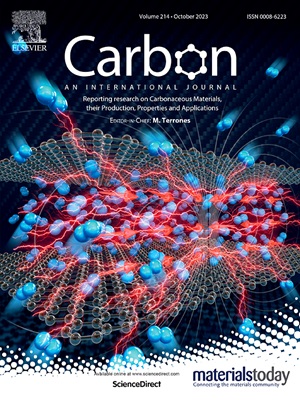一体机:一种基于碳量子点和二乙烯三胺五乙酸的放射性铀清洁剂,集去污和实时检测于一体
IF 10.5
2区 材料科学
Q1 CHEMISTRY, PHYSICAL
引用次数: 0
摘要
在现场核救援处置过程中,高效开展去污作业和去污后快速检测是核去污工作的重点。然而,现有的去污和检测分为不同的步骤,去污效果需要借助专用仪器来判断,这在一定程度上阻碍了核救援工作。为了有效地解决这一问题,通过酰胺化反应将二乙烯三胺五乙酸(DTPA)掺杂到碳量子点(CQDs)表面,研制出一种新型洗涤剂(CQDs-DTPA)。CQDs-DTPA对UO22+的去污效果达到76.8%,优于临床认证DTPA(去污效果71.3%)。CQDs-DTPA对UO22+具有很高的选择性和敏感性,暴露10 s后发生荧光猝灭。在去污过程中,可以发现CQDs-DTPA的荧光强度随着铀的去除而增加,并最终恢复到初始值,这表明CQDs-DTPA具有实时监测作用。此外,安全性实验评价充分证实了CQDs-DTPA在实际应用中的安全性。本研究表明,CQDs-DTPA可作为放射性铀去污剂实时检测去污效果,也可为开发其他放射性核素快速去污剂提供参考。本文章由计算机程序翻译,如有差异,请以英文原文为准。
All-in-One: One radioactive uranium detergent integrated decontamination and real-time detection based on carbon quantum dots and diethylenetriaminepentaacetic acid
During on-site nuclear rescue and treatment, efficiently carrying out decontamination operations and conducting rapid detection after decontamination are the key points in nuclear decontamination work. However, the existing decontamination and detection are divided into different steps and the decontamination effect needs to be judged by means of special instruments, which hinder the nuclear rescue work to a certain extent. To effectively solve this problem, a novel detergent (CQDs-DTPA) was developed by doping diethylenetriaminepentaacetic acid (DTPA) onto the surface of carbon quantum dots (CQDs) through an amidation reaction. The decontaminating effect of CQDs-DTPA on UO22+ reached 76.8 %, which is better than that of the clinical certification DTPA (decontaminating effect of 71.3 %). CQDs-DTPA is highly selective and sensitive to UO22+, and fluorescence quenching occurs after 10 s of exposure. During the decontamination process, it can be found that the fluorescence intensity of CQDs-DTPA increases with the removal of uranium and eventually returns to the initial value, which indicates the real-time monitoring role of CQDs-DTPA. In addition, safety experimental evaluations fully confirmed the safety of CQDs-DTPA in practical applications. This study indicated that CQDs-DTPA could serve as a radioactive uranium detergent with real-time detection of the decontamination effect, which could also provide a reference for developing other radionuclides' rapid decontamination agents.
求助全文
通过发布文献求助,成功后即可免费获取论文全文。
去求助
来源期刊

Carbon
工程技术-材料科学:综合
CiteScore
20.80
自引率
7.30%
发文量
0
审稿时长
23 days
期刊介绍:
The journal Carbon is an international multidisciplinary forum for communicating scientific advances in the field of carbon materials. It reports new findings related to the formation, structure, properties, behaviors, and technological applications of carbons. Carbons are a broad class of ordered or disordered solid phases composed primarily of elemental carbon, including but not limited to carbon black, carbon fibers and filaments, carbon nanotubes, diamond and diamond-like carbon, fullerenes, glassy carbon, graphite, graphene, graphene-oxide, porous carbons, pyrolytic carbon, and other sp2 and non-sp2 hybridized carbon systems. Carbon is the companion title to the open access journal Carbon Trends. Relevant application areas for carbon materials include biology and medicine, catalysis, electronic, optoelectronic, spintronic, high-frequency, and photonic devices, energy storage and conversion systems, environmental applications and water treatment, smart materials and systems, and structural and thermal applications.
 求助内容:
求助内容: 应助结果提醒方式:
应助结果提醒方式:


